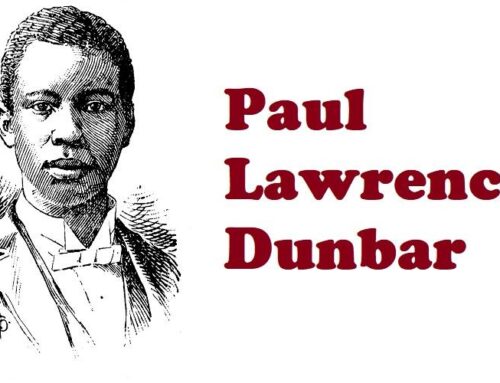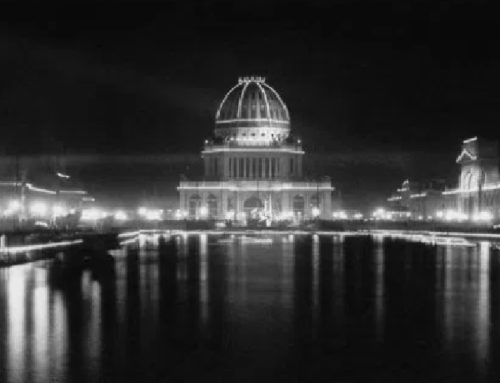
Paine’s “Columbian March”
This is Part 4 of our series “Opening Day of the World’s Fair,” which explores the events of May 1, 1893, at the World’s Columbian Exposition in Chicago. The full series can be found here.
The Exposition Orchestra
Under the main arch of the Administration Building, and in front of a great sounding board, sat the 150 musicians* of the Exposition Orchestra, under the baton of conductor Theodore Thomas. The grandstand beneath them filled with more than 2000 invited guests and dignitaries, from the President of the United States and his cabinet to the Mayor of Chicago and his City Council. Flooding the plaza beneath the stage, an estimated quarter-million spectators waited for the Opening Ceremony of the 1893 World’s Fair to begin.
* The size of the orchestra for the Opening Ceremony was frequently listed as 600, though that number could barely have fit in the space allocated in the stands. The orchestra typically performed with 114 musicians at other times during the Fair.
The original plan had been to preface the speechmaking of the ceremony with a performance employing a grand chorus of 1,000 voices. Owing to an oversight in designing the platform, this feature was eliminated. Nonetheless, Prof. William Lawrence Tomlins, director of Chicago’s Apollo Club chorus, had arrived earlier that morning to assist with the set-up of music stands for the orchestra. His ensemble would perform later in the day for the inauguration of the Woman’s Building.
The great orchestra was in place shortly before 11 o’clock, and musicians nervously fumbled the pages of their sheet music. After the dignitaries were seated, conductor Thomas–silk hatted and gloved–stepped upon the raised platform and lifted his baton.

Opening Day Ceremonies at the Administration Building. [Image from World’s Columbian Exposition Photographs by C. D. Arnold, Ryerson & Burnham Archives.]
Opening the Opening
At 11:22 a.m. the big orchestra cut loose. The ceremonies officially began as the musicians broke into the triumphant strains of John Knowles Paine’s “Columbian March and Hymn.” The opening bars of this impressive piece hushed the crowd into admiring awe. The splendid and triumphant music swept down the mighty stretch of the basin and calmed the rising tide of humanity crashing against the shore of the grandstand. The martial air lasted fifteen minutes.*
* The length of the piece reported by the San Sabo News seems rather long, unless the verse were repeated several times. The work is noted elsewhere to be only five minutes in length.
Premiere of the “Columbian March”

Conductor Theodore Thomas. [Image from Russell, Charles Edward The American Orchestra and Theodore Thomas, Doubleday, Page & Co. 1927).]
For that first concert of Paine’s piece, Theodore Thomas conducted a 190-piece orchestra accompanied by an immense Columbian Chorus (reportedly having between 5,000 and 5,500 voices) under the direction of William L. Tomlins. Elsewhere in the great hall, John Philip Sousa led his newly formed military band in a hopeless attempt to support the orchestra and chorus. Few of the 100,000 or so spectators in attendance on Dedication Day heard much of the piece, as the sounds of the voices and instruments were swallowed up in the cavernous space.
A flattering description of the inaugural performance is recorded in Benjamin Cummings Truman’s History of the World’s Fair:
Professor Thomas waved his baton, and with one burst of melody the orchestra sounded the opening strain of the “Columbian March.” The effect was instantaneous and wonderful. A hush fell upon the multitude, and all through the great auditorium penetrated the harmony of Professor Paine’s composition. Then 5,000 voices in one tremendous chorus swelled the volume of the music. For five minutes the audience sat as though entranced. And many seconds had elapsed after the baton had been given its final wave before the burst of applause came. It had been useless to attempt to quiet that throng until it had worked off the enthusiasm acquired while the “Columbian March” was being produced.
The immense throng became spellbound as it listened
Opening Day’s repeat presentation of the “Columbian March” also suffered from acoustic limitations. As the orchestra under the arch of the Administration Building played, someone standing on the south end of the Manufactures Building could see the motion of the musicians’ arms, but not hear a note. As was the case for most of the ceremony, few in the crowd heard much of anything happening on the grandstand.
Those who were standing close enough to catch the strains of music, though, were impressed. A reporter from the Tribune declared the piece “triumphant and victorious in character.”
The prelude sounded like a battle call. It was a stirring passage for the trumpets, the small drums furnishing an accompaniment like the rattling of musketry. The vast assemblage became hushed and silent as the war-like opening number merged into a stately and massive melody. Wonderment, astonishment, and admiration took the place of the previous enthusiasm, and the immense throng became spellbound as it listened to the ravishing arrangement of chords and melodic surprises. The predominant motif was exalted and evenly sustained. The concluding passage of the composition was like an anthem and was given with fortissimo effects. In one grand, swelling chord the music of the march finished. When its strains had died away in echo, a great cheer ran through the crowd.

“Opening Ceremonies at the Administration Building” from the Chicago Daily Tribune, May 2, 1893.
Columbia’s high inspiring song

Composer John Knowles Pain. [Image from Elson, Louis Charles The History of American Music (Macmillan, 1904).]
Paine completed his “Columbian March” by August 1892, at which time the Liberal Arts Department of the World’s Columbian Exposition dispatched a press release that included the text of his lyrics. A choral edition, scored for piano and voice, was published by Oliver Ditson of Boston in 1892 using the title “Columbus March and Hymn.”
Here are the accompanying lyrics, not heard by the audience on Opening Day of the Fair:
All hail and welcome nations of the Earth!
Columbia’s greeting comes from every state.
Proclaim to all mankind the world’s new birth
Of freedom, age on age shall consecrate.
Let war and enmity forever cease;
Let glorious art and commerce banish wrong.
The universal brotherhood of peace,
Shall be Columbia’s high inspiring song.
The Christian Cynosure had a bone to pick with Paine’s lyrics, publishing this query in advance of its first performance:
Really, we would like to know what is meant by “the world’s new birth of freedom,” and what is the use of trying to unite all nations in “the brotherhood of peace” without the aid of Christianity? Will some one, not a pagan, tell us.
The record is silent on whether or not they received a satisfactory answer.
Hear the Columbian March again

“Columbus March and Hymn” sheet music.
The “Columbian March and Hymn” appears to have been performed a few more times in the coming months at various concerts. This is difficult to confirm, however, as several other works go by the same or similar name. No recordings of the piece are known to exist.
We are pleased to offer a new recording of “Columbian March and Hymn” on the WorldsFairChicago1893 YouTube channel: https://www.youtube.com/watch?v=e4cXpSozJeo
Our dear friend B.P. created this using the choral score. Perhaps for the first time nearly 125 years, audiences can once again hear John Paine’s composition for the World’s Columbian Exposition. Enjoy!
SOURCES
(See our note about sources here.)
Dedicatory and Opening Ceremonies of the World’s Columbian Exposition. Stone, Kastler & Painter, 1893, p. 259.
“Exposition Poetry” Christian Cynosure September 15, 1892, p. 8.
“The Great Fair Open” San Saba (TX) News May 12, 1893, p.2.
“How it was Opened” Chicago Inter Ocean May 2, 1893, p. 1.
“In the Grand Stand” Chicago Daily Tribune May 2, 1893, p. 1.
“Music Admirable and Effective” Chicago Daily Tribune May 2, 1893, p. 1.
“Musical Notes” New York Daily Tribune August 21, 1892, p. 8.
“Opening Ceremonies World’s Columbian Exposition” in Columbian Exposition Dedication Ceremonies Memorial. Metropolitan Art Engraving & Publishing Company, 1893, pp. 212-224.
Pickett, Montgomery Breckinridge “Opening of the Great Fair” Harper’s Weekly May 13, 1893, p. 442.
“Starting the Machinery” New York Tribune May 2, 1893, p. 11.
Truman, Benjamin Cummings History of the World’s Fair. Mammoth Publishing, 1898, p. 95.
“Viewed from Above” Chicago Daily Tribune May 2, 1893, p. 5.
“‘White City’ Half in Cloud Land” Chicago Daily Tribune May 2, 1893, p. 1.






Leave A Comment